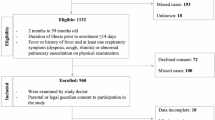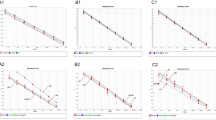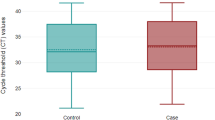Abstract
In the present study, we analyzed the effect of a preceding respiratory syncytial virus (RSV) infection of human respiratory epithelial cells on the adherence of Streptococcus pneumoniae tested by means of a cytometric fluorescence assay. Adherence of clinically relevant pneumococcal serotypes 3, 9, 14, 18, 19, and 23 was studied using uninfected and RSV-infected monolayers. To this end, monolayers of both human nasopharyngeal cells (HEp-2) and pneumocyte type II cells (A549) were infected with RSV serotype A. Adherence to uninfected epithelial cells varied between pneumococcal serotypes. After RSV infection of the monolayers, all serotypes showed a strongly (2- to 10- fold) and significantly increased adherence when compared with adherence to uninfected monolayers. Enhanced adherence was observed with both cell lines. By fluorescence and scanning electron microscopy, we observed redistribution of pneumococcal adherence over the epithelial surface due to RSV infection, with dense bacterial accumulations near to epithelial syncytia.
Similar content being viewed by others
Log in or create a free account to read this content
Gain free access to this article, as well as selected content from this journal and more on nature.com
or
Abbreviations
- RSV:
-
respiratory syncytial virus
- CPE:
-
cytopathological effect
- PFU:
-
plaque-forming units
- CFU:
-
colony-forming units
- IMDM:
-
Iscove's modified Dulbecco's medium
- MOI:
-
multiplicity of infection
References
Centers for Disease Control and Prevention 2001 From the Centers for Disease Control and Prevention. Respiratory syncytial virus activity—United States, 1999-2000 season. JAMA 285: 287–288.
Robinson KA, Baughman W, Rothrock G, Barrett NL, Pass M, Lexau C, Damaske B, Stefonek K, Barnes B, Patterson J, Zell ER, Schuchat A, Whitney CG 2001 Epidemiology of invasive Streptococcus pneumoniae infections in the United States, 1995-1998: opportunities for prevention in the conjugate vaccine era. JAMA 285: 1729–1735.
Hament JM, Kimpen JL, Fleer A, Wolfs TF 1999 Respiratory viral infection predisposing for bacterial disease: a concise review. FEMS Immunol Med Microbiol 26: 189–195.
Heikkinen T 2000 The role of respiratory viruses in otitis media. Vaccine 19:S51–S55.
Chonmaitree T, Heikkinen T 2000 Viruses and acute otitis media. Pediatr Infect Dis J 19: 1005–1007.
Heikkinen T, Chonmaitree T 2000 Viral-bacterial synergy in otitis media: implications for management. Curr Infect Dis Rep 2: 154–159.
Andrade MA, Hoberman A, Glustein J, Paradise JL, Wald ER 1998 Acute otitis media in children with bronchiolitis. Pediatrics 101: 617–619.
Chonmaitree T, Henrickson KJ 2000 Detection of respiratory viruses in the middle ear fluids of children with acute otitis media by multiplex reverse transcription: polymerase chain reaction assay. Pediatr Infect Dis J 19: 258–260.
Kim PE, Musher DM, Glezen WP, Rodriguez-Barradas MC, Nahm WK, Wright CE 1996 Association of invasive pneumococcal disease with season, atmospheric conditions, air pollution, and the isolation of respiratory viruses. Clin Infect Dis 22: 100–106.
Heiskanen-Kosma T, Korppi M, Jokinen C, Kurki S, Heiskanen L, Juvonen H, Kallinen S, Sten M, Tarkiainen A, Ronnberg PR, Kleemola M, Makela PH, Leinonen M 1998 Etiology of childhood pneumonia: serologic results of a prospective, population-based study. Pediatr Infect Dis J 17: 986–991.
Butler JC, Breiman RF, Lipman HB, Hofmann J, Facklam RR 1995 Serotype distribution of Streptococcus pneumoniae infections among preschool children in the United States, 1978–1994: implications for development of a conjugate vaccine. J Infect Dis 171: 885–889.
Gray BM, Converse GM, Dillon HC Jr 1979 Serotypes of Streptococcus pneumoniae causing disease. J Infect Dis 140: 979–983.
Kalin M 1998 Pneumococcal serotypes and their clinical relevance. Thorax 53: 159–162.
Rumke HC, Hermans PWM, Bogaert D, de Groot R 2002 Pneumokokken vaccinatie van jonge kinderen in het Rijkvacinatieprogramma?. Infectie Bulletin 12: 217–223.
Sanford BA, Smith N, Shelokov A, Ramsay MA 1979 Adherence of group-B streptococci and human erythrocytes to influenza A virus-infected MDCK cells. Proc Soc Exp Biol Med 160: 226–232.
Fainstein V, Musher DM, Cate TR 1980 Bacterial adherence to pharyngeal cells during viral infection. J Infect Dis 141: 172–176.
Tamura GS, Kuypers JM, Smith S, Raff H, Rubens CE 1994 Adherence of group-B streptococci to cultured epithelial cells: roles of environmental factors and bacterial surface components. Infect Immun 62: 2450–2458.
Heikkinen T 2000 Role of viruses in the pathogenesis of acute otitis media. Pediatr Infect Dis J 19:S17–S22.
Bakaletz LO, Hoepf TM, DeMaria TF, Lim DJ 1988 The effect of antecedent influenza A virus infection on the adherence of Hemophilus influenzae to chinchilla tracheal epithelium. Am J Otolaryngol 9: 127–134.
Bakaletz LO 1995 Viral potentiation of bacterial superinfection of the respiratory tract. Trends Microbiol 3: 110–114.
Saadi AT, Blackwell CC, Raza MW, James VS, Stewart J, Elton RA, Weir DM 1993 Factors enhancing adherence of toxigenic Staphylococcus aureus to epithelial cells and their possible role in sudden infant death syndrome. Epidemiol Infect 110: 507–517.
Hakansson A, Kidd A, Wadell G, Sabharwal H, Svanborg C 1994 Adenovirus infection enhances in vitro adherence of Streptococcus pneumoniae. Infect Immun 62: 2707–2714.
El Ahmer OR, Raza MW, Ogilvie MM, Weir DM, Blackwell CC 1999 Binding of bacteria to HEp-2 cells infected with influenza A virus. FEMS Immunol Med Microbiol 23: 331–341.
Patel J, Faden H, Sharma S, Ogra PL 1992 Effect of respiratory syncytial virus on adherence, colonization and immunity of non-typable Haemophilus influenzae: implications for otitis media. Int J Pediatr Otorhinolaryngol 23: 15–23.
Davison VE, Sanford BA 1981 Adherence of Staphylococcus aureus to influenza A virus-infected Madin-Darby canine kidney cell cultures. Infect Immun 32: 118–126.
Sanford BA, Shelokov A, Ramsay MA 1978 Bacterial adherence to virus-infected cells: a cell culture model of bacterial superinfection. J Infect Dis 137: 176–181.
Saadi AT, Blackwell CC, Essery SD, Raza MW, El Ahmer OR, MacKenzie DA, James VS, Weir DM, Ogilvie MM, Elton RA, Busuttil A, Keeling JW 1996 Developmental and environmental factors that enhance binding of Bordetella pertussis to human epithelial cells in relation to sudden infant death syndrome (SIDS). FEMS Immunol Med Microbiol 16: 51–59.
Raza MW, Ogilvie MM, Blackwell CC, Stewart J, Elton RA, Weir DM 1993 Effect of respiratory syncytial virus infection on binding of Neisseria meningitidis and Haemophilus influenzae type b to a human epithelial cell line (HEp-2). Epidemiol Infect 110: 339–347.
Elahmer OR, Raza MW, Ogilvie MM, Blackwell CC, Weir DM, Elton RA 1996 The effect of respiratory virus infection on expression of cell surface antigens associated with binding of potentially pathogenic bacteria. Adv Exp Med Biol 408: 169–177.
Raza MW, Blackwell CC, Ogilvie MM, Saadi AT, Stewart J, Elton RA, Weir DM 1994 Evidence for the role of glycoprotein G of respiratory syncytial virus in binding of Neisseria meningitidis to HEp-2 cells. FEMS Immunol Med Microbiol 10: 25–30.
Wang SZ, Hallsworth PG, Dowling KD, Alpers JH, Bowden JJ, Forsyth KD 2000 Adhesion molecule expression on epithelial cells infected with respiratory syncytial virus. Eur Respir J 15: 358–366.
Author information
Authors and Affiliations
Corresponding author
Rights and permissions
About this article
Cite this article
Hament, JM., Aerts, P., Fleer, A. et al. Enhanced Adherence of Streptococcus pneumoniae to Human Epithelial Cells Infected with Respiratory Syncytial Virus. Pediatr Res 55, 972–978 (2004). https://doi.org/10.1203/01.PDR.0000127431.11750.D9
Received:
Accepted:
Issue date:
DOI: https://doi.org/10.1203/01.PDR.0000127431.11750.D9
This article is cited by
-
Pneumococcal colonization and coinfecting respiratory viruses in children under 5 years in Addis Ababa, Ethiopia: a prospective case–control study
Scientific Reports (2024)
-
Diversity of upper respiratory tract infections and prevalence of Streptococcus pneumoniae colonization among patients with fever and flu-like symptoms
BMC Infectious Diseases (2019)
-
Airway response to respiratory syncytial virus has incidental antibacterial effects
Nature Communications (2019)
-
Bacterial flagellin promotes viral entry via an NF-kB and Toll Like Receptor 5 dependent pathway
Scientific Reports (2019)
-
A microbiome case-control study of recurrent acute otitis media identified potentially protective bacterial genera
BMC Microbiology (2018)



